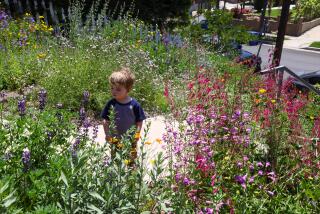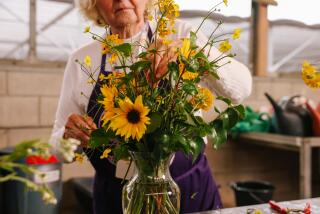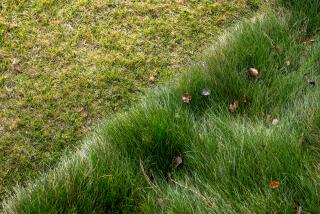GARDENING : In a Cool, Lush Retreat, You’ll Have It Made in the Shade
- Share via
Even though we live in sunny Southern California, shade is common in many gardens. Condos and new houses built close together block out the sun, and large trees in older neighborhoods cast shadows in many yards.
This, however, doesn’t mean that you can’t have a lush garden. A variety of plants thrive in darker surroundings.
Unlike sun gardens, shade landscapes offer you a lush, cool sanctuary, especially in the hot summer and fall months.
“The shade garden in my front walkway is about 15 degrees cooler than the rest of the yard,” says Nola Skyler of Huntington Beach, who is on the board of directors for the UC Irvine Arboretum and president of the volunteers program. “Whenever it gets warm in the house, I just open the front door and get an automatic cool breeze.”
Shade gardens are also less likely to be bothered by weeds, and often require less water.
If you want to grow a shade garden, you’ll be glad to know that there is a wide variety of shade trees, shrubs, ferns, ground covers, annuals and perennials from which to choose.
An attractive shade garden often contains a combination of plant types.
“When planning your shade garden, consider the texture and structure of your plants, their eventual size, flower color and leaf color and type,” says John Greenwood, a California licensed landscape architect with John J. Greenwood & Associates Inc. in San Juan Capistrano. The firm is a member of the American Society of Landscape Architects.
“Before making selections, try to visualize how all of the plants will look together,” he says.
Because of their large size, your first consideration should be what “tree-like” plants you would like to incorporate.
“Several different types of ficus like the shade, especially the well-known Ficus benjamina, or weeping fig,” says Steve Hollister, manager of Armstrong Garden Center in Irvine and a California certified nurseryman. “The tupidanthus calyptratus also does really well in shade. This is a bushy, pest-resistant plant that can also take full sun near the coast. It reaches 12 to 15 feet tall, but can be heavily pruned if you wish to keep it more contained.”
A similar plant is the schefflera.
Or try the thread-leaf false aralia, a graceful lacy plant with bronze foliage that contrasts nicely with other green-leaved plants. It grows to about six feet in height or can be trimmed back.
A variety of attractive, often colorful shrubs also thrive in the shade, including camellias and azaleas, of which there are a wide selection at nurseries now.
“There are two major types of camellias to choose from,” Hollister says. “There is the Camellia japonica, which has big glossy leaves and large spectacular flowers that bloom in the winter and early spring. This type can get six to eight feet in height.
“The other category is the Camellia sasanqua, which has smaller leaves and flowers,” he says. “It comes in a variety of forms, including low and spreading (and) upright, and some even grow in baskets. The sasanquas bloom earlier than the japonicas.”
Growing both types gives you a long flower period.
Another popular shade-loving shrub is the showy azalea. Hollister suggests a few azalea varieties, including red ruffle wings, a compact azalea that reaches just two to three feet tall.
“It probably blooms better than any other azalea in this area,” Hollister says. “There is also the foremosa azalea, a large vigorous shrub that grows three to five feet. It has deep lavender flowers and blooms January through April.”
Gardenias are another shrub that likes filtered sun. Known for their pleasing fragrance, these plants bloom spring through summer. Good gardenia choices include the classic corsage flower, the mystery gardenia. This shrub grows about three to four feet and has large white flowers. Or try the veitchii, a smaller and more compact ever-blooming gardenia that is great for container growing.
Another popular shrub is the hydrangea, which comes in several colors, including pink, blue, red and white. This deciduous shrub should be pruned back in winter when it is dormant so that you’ll get a healthy summer and fall bloom, Hollister says.
Although fuchsias bloom most of the year, you won’t find this delicate shade-loving plant in the nurseries until spring. They are most popular as hanging basket plants but also come in an upright version, both of which are a delightful addition to any shade garden.
Add a tropical, cool feeling to your shade garden with the addition of ferns. There is a wide variety available.
“The leather fern is a small plant that gets just two to three feet tall and wide,” Hollister says. “This is the fern florists use with rose arrangements. There is also the mother fern, which is a symmetrical tree fern that reaches three feet. It has light apple green leaves with contrasting dark stems.”
If it’s a bigger plant you want, try the New Zealand tree fern, which has a wing span of about six feet or more. It doesn’t grow tall but tends to spread sideways. The even larger Australian tree fern has a six to eight foot wing span and will grow eight to 10 feet tall fairly quickly.
“If you have the space, it’s a spectacular and majestic tree fern,” Hollister says.
In the way of ground cover there is the rabbit’s foot fern, which spreads along the ground with fuzzy little “runners” that resemble rabbit feet.
Other shade-loving ground covers include baby’s tears, which grows into a lush green carpeting, and Japanese spurge, an evergreen ground cover with fragrant white flower clusters.
For a little seasonal color, there are a few good flowers to choose from for your shade garden. One of the most popular are impatiens, which can grow as perennials if well taken care of. They come in a rainbow of colors and will bloom most of the year. Some grow low to the ground, while others can reach a couple of feet or more.
This is also the time of year to plant primrose.
There are three main types that like shade: the fairy primrose, a delicate flower in pastels that grows in clusters; the English primrose, a short plant in bright, hard colors such as bronze, red, yellow and blue, and the Chinese primrose, which has large flowers in pastels that last from fall through spring and sometimes even into summer.
Other shade perennial flowers Greenwood recommends include begonias, campanula, Kaffir lily, coleus (treated as an annual), liriope, narcissus, ophiopogon, phlox, vinca and viola (also usually treated as an annual).
Great vines to add to your shade garden include cissus, parthenocissus, star jasmine and hedera.
To care for your shade garden, keep in mind that it is slightly different than a sun area. Although most shade plants need to be kept moist, don’t over water them.
“The shade garden can’t tolerate a lot of water,” Skyler says. “Many shade plants are susceptible to wet feet. Azaleas, for instance, are extremely sensitive and can easily die from too much water.”
In the summer, though, keep a watchful eye on some shade plants that tend to dry out quickly.
“Plants like begonias, fuchsia and azaleas have shallow roots and during growth and bloom use a lot of water,” Greenwood says. “They are especially susceptible to drying out in hot, windy weather. Mulch heavily and mist them when the air is really dry.”
Part of keeping your shade plants healthy is to make certain they have good drainage.
“Water has to pass through the root zone quickly or these plants will suffer from lack of oxygen, which can lead to root rot,” Greenwood says.
To guarantee good drainage, prepare the soil well before planting, making sure to generously amend with redwood compost or planter mix.
Most shade plants are acid loving and therefore need acid fertilizers. You can buy azalea and camellia food or an all-purpose acid fertilizer.
Many shade plants do well in containers. When potting plants, make certain to use potting soils for acid-loving plants and to fertilize the potted plants more often than their ground counterparts. Hollister recommends liquid fertilizers for containers rather than the granule type, because the liquids are less likely to burn plant roots.






